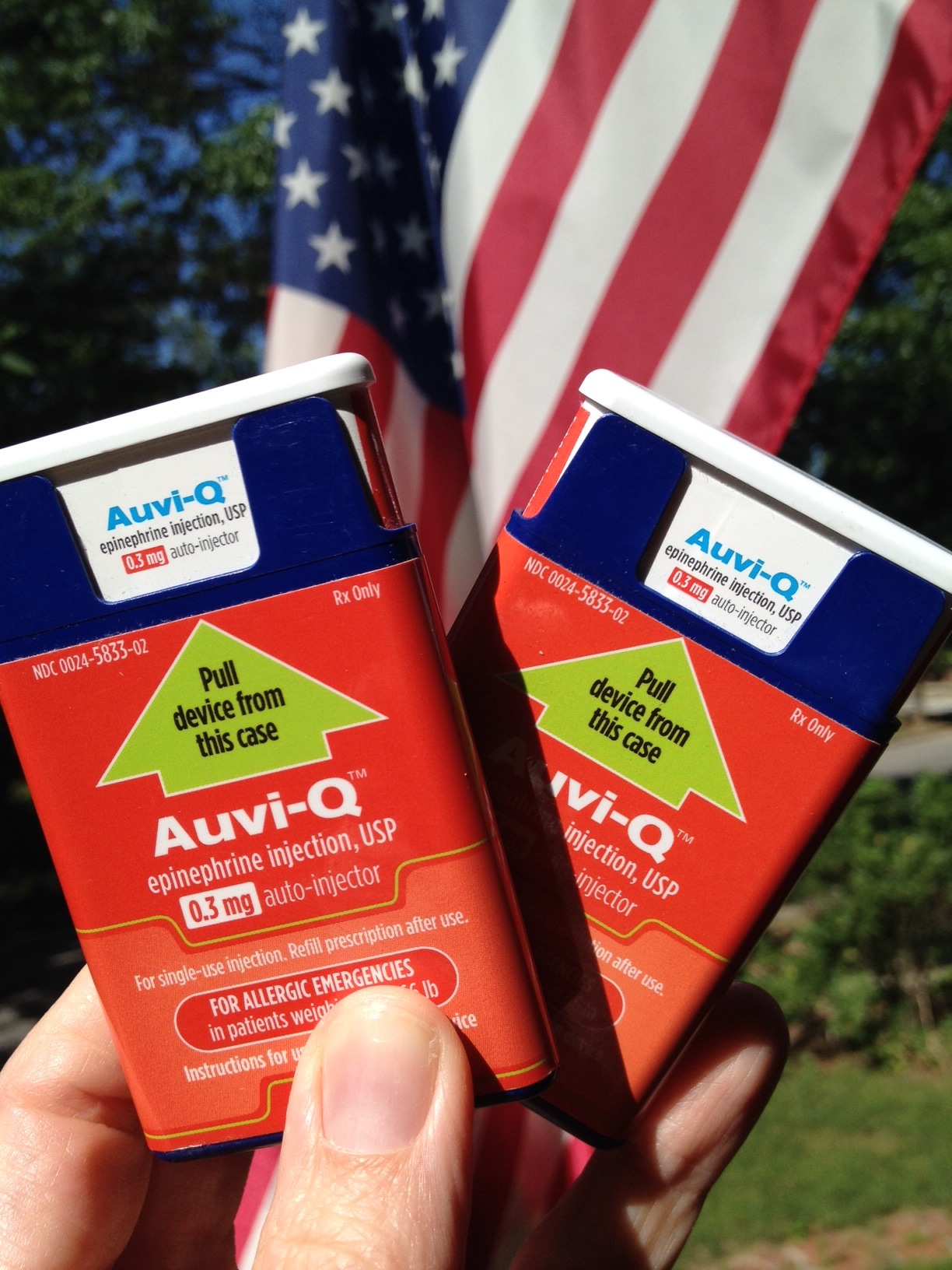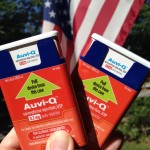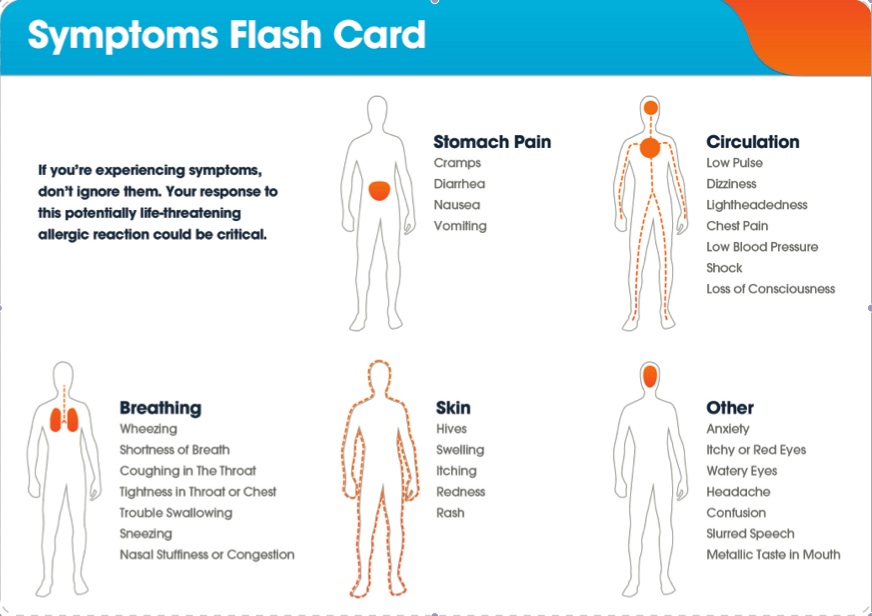
UPDATE:
FARE has created an excellent 15-minute online class:
How to Save a Life: Recognizing and Responding to Anaphylaxis
Original post:
In a fit of housecleaning last spring, I recycled all my old food-allergy training files since they were 5+ years old. I figured it wouldn’t be very hard to find a good one-pager on the basics of food allergy and anaphylaxis in time for my annual teacher training. Wrong.
I started at the top of the food chain, the biggest food allergy advocacy organization in the U.S.:
FoodAllergy.org: Treatment and Managing Reactions page
- Best find: a 2-page PDF summarizing signs of anaphylaxis and directions for using the 3 epinephrine injectors now available. Comprehensive and to the point, but I hoped to find something with a little more pizzazz.
Maybe my hard copy of Food Allergies for Dummies, by Robert A. Wood, MD, would have a tear-out one-pager. Nope. The chapter on how to handle an emergency is 5 pages long — great information but not exactly grab-and-go.
Then I went to a specific site for children:
Kids with Food Allergies: School and Preschool page
- Best find: an extensive list of webinars, blog posts, and guides for specific situations. Perfect for me, but I would not suggest it as a resource for a busy teacher.
The KFA site led me to:
CDC: Food Allergies Publications & Resources page
- Best find: a 2-page FDA summary of food allergies (PDF). OK, but it’s a hard-to-read riot of italics, bold, and various typefaces.
- Laugh or you’ll cry find: a daunting 100-page PDF guide for managing food allergies at school. Who’s going to read that?
Losing hope, I turned to the maker of the most popular epinephrine injector. Surely their marketing team has created a clear, concise, consumer-friendly one-pager on food allergy and anaphylaxis.
EpiPen: When to use the EpiPen page
- Best find: a link to how to recognize the signs of anaphylaxis
- Laugh or you’ll cry find: the graphic is blurry and cuts off the title.
Seriously? Doesn’t anyone review these pages with the end-users in mind? I can’t walk into a 20-minute meeting with my son’s teachers and hand them a 100-page guide (CDC), a list of webinars (KFA), or a graphic with information cut off (EpiPen). I don’t have time for their blah-blah-blah.
I thought about how Joyce Lee, MD, MPH would approach this problem. She is one of my gurus, both professionally and as a peer food-allergy mom. Feast your eyes:
- Her slides introducing herself and the concept of Doctor as Designer
- When her son was 6 years old she helped him create 3 videos about allergy and asthma which blow the doors off anything else I’ve seen online. Check them out on his tumblr: I have food allergies.
- The We #MakeHealth Fest was the latest occasion for her family to co-design allergy education materials.
And finally:
- Look at the ingenious booklet she gives to her son’s teachers, detailing his allergens and what to do in an emergency.
But I don’t have time (or frankly the skills) to create a bespoke hand-out. There must be someone who has thought about how to get the key information across in a compelling format for a broad market. I asked myself: What is the most thoughtful organization in allergy treatment right now? Duh. Auvi-Q.
 Created by two brothers who grew up hating — and therefore not carrying — their EpiPens, the Auvi-Q is a fits-in-your-pocket epinephrine injector. Captain Obvious alert: if you design something that is easy to carry, patients will be more likely to have it with them when they need it.
Created by two brothers who grew up hating — and therefore not carrying — their EpiPens, the Auvi-Q is a fits-in-your-pocket epinephrine injector. Captain Obvious alert: if you design something that is easy to carry, patients will be more likely to have it with them when they need it.
The brothers also addressed the second major barrier to treatment: clueless bystanders who don’t know how to use an injector. As soon as you take it out of its case the Auvi-Q guides you with clear, audible instructions. It’s a genius response to another old “non-adherence” problem. Don’t scold — innovate! (For more, read this New York Times story about Eric and Evan Edwards and Joyce Lee’s post, “Meet Auvi-Q, the new Siri for Allergy Patients.”)
Maybe the Auvi-Q marketing team created a one-pager to give to teachers. I crossed my fingers and clicked on their site:
Auvi-Q: Anaphylaxis Symptoms page
- Best find: Symptoms Flash Card (PDF). Yes! This is what I’ve been looking for.
- Laugh or you’ll cry find: It’s not shareable on social media as a PDF. So I hacked a screenshot into a JPEG. (I’m no Joyce Lee, but this I can do.)
I wish it had not taken me this long to find a shareable, well-designed anaphylaxis guide, but in a way, I’m glad it did. I learned, once again, that there is so much to learn from expert peers (like Joyce) and from motivated patients (like the Edwards brothers). And so much potential for progress.

Love it!
Susannah, thank you once again for generously sharing your journey, so that we can learn from your finds and especially what we can learn from the clarity on what you wish you could more easily find.
What started as a frustrating “I have to get this over with” search became a “interesting – why is this so hard and what can we learn” journey.
Hi Susannah, Allergyhome.org has numerous free training resources on its website that are created in compliance with that 100-page CDC manual. Also some really nice resources are at http://neahin.org/allergy/.
I hope you and your son have a safe and healthy school year!
Lynda
Wonderful, Lynda! Thanks so much. I will take a look.
Thanks for sharing your journey Susannah and for sharing the card! I too was frustrated by the lack of useful resources which led us to create our own solutions! Education is so important but I do wonder about it’s effectiveness. B and I have made all sorts of resources together, but I still doubt myself at times, and when I read stories like these, http://goo.gl/msL4ut I have to say that I am haunted. It’s that one misstep, that one missed symptom, that one time that the food was contaminated…I wish there were more solutions/fixes even before we get to the point of using the epipen.
Haunted. Yes. That’s how I feel, too, reading about Abbie Benford. Or Natalie Giorgi, another teen who had followed all the rules, whose dad administered the epinephrine right away, but who died after one bite of the wrong treat.
Lynda Mitchell shared a link to a handout that I’ll include in the packet I bring to school this week. It answers the question I get a lot these days: “Is there a cure for food allergy? I keep hearing about cures in the news.” Sadly, not yet. So we have to do all our education, our preparation of lunches, our drills.
Good news: N is now at a school that does not allow birthday parties or any outside food (HALLELUJAH). And teachers are asked not to use food as an incentive or reward for good behavior (AMEN). There will be new minefields as he gets older but I am leaving those elementary school cupcake battles behind and I’m not looking back.
Hi again Susannah,
If you are looking for one-page handout types of materials, here are some things we have you can print in pdf:
What’s the Big Deal about Food Allergies?
http://community.kidswithfoodallergies.org/blog/whats-the-big-deal-about-food-allergies-free-community-handout
Anaphylaxis: Severe Allergic Reactions
http://community.kidswithfoodallergies.org/blog/anaphylaxis-severe-allergic-reactions-handout
Children with Food Allergies: What Parents Need to Know (can be useful for caregivers as well).
http://community.kidswithfoodallergies.org/blog/children-with-food-allergies-what-parents-need-to-know
Once we get our new website later this year, things will be a lot easier to find!
Lynda
Again, thank you, Lynda! You know I’m a longtime fan of your site. Nobody has more in-depth content than you do about living with (and thriving with) children with food allergies. These are great resources.
I wish wish wish I’d seen this during the just-finished Digital Health Days conference in Stockholm. I’m going to tweet this into the #dhd14 feed right now. AND I’m going to spotlight it at today’s follow-up workshop at Karolinska Institute.
You are the one who taught me the value and validity of articulating our journey in ways that light the way for innovators. Every time I speechify “Can we make it easier to do the right thing??” that’s you up there.
Looking forward to continuing the journey.
In the words of Ted Eytan, “no conversation is ever over.” Your sharing it on Twitter today is giving it a second round of attention — thanks!
Funny, I thought of you when I wrote about “non-adherence” among allergy patients who didn’t care to stuff an awkward tube in their pants or to strap it to their leg (seriously, that is a suggested work-around) or to wear a (I can hardly type it without laughing) fanny pack.
Not to pull out the old “what if air travel was like health care” trope, but this experience reminds me of the difference between flying Virgin America and United, DC-SFO.
Virgin is like the Auvi-Q, treating people like it’s 2014, not 1984. I always feel kind of cool walking onto a Virgin plane, with its nightclub lighting, normally-dressed flight attendants, and fun safety video.
United, by contrast, always makes me feel like I’m walking onto a diorama about the history of flight. And I can’t help but smile ruefully at their safety demonstration. See, I’ve actually been evacuated in an emergency from a United flight. I got to slide down the slide and everything. Guess what? It was my fellow passengers who took control of the situation, calling out the location of open exits and catching people at the bottom of the slide. Peer to peer, baby!
That’s the reality of our lives, right? When the crisis comes, you are probably not going to be standing outside your doctor’s office or the best hospital for your condition. You are going to triage. You are going to ask bystanders for help. You are going to work with the tools at hand.
Spare me the blah-blah-blah of long safety videos, illegible and poorly designed resources, and robotic reminders. Give me one-pagers that work, cool tools, and human-centered design.
And, here’s a tip: don’t take your salad on the emergency slide. Avocado everywhere. But that’s another post.
Just realized I never came back to this thread to say I finally wrote up my experience getting evacuated from a United flight:
https://medium.com/@SusannahFox/what-i-learned-going-down-an-emergency-slide-b05717355ed5
Enjoy 🙂
Your comment, “I don’t have time for their blah blah blah” got me thinking (as ever) about when and why best practices shift.
More from The Duh Department: digital has changed everything, especially the speed with which we expect to find accurate, useful information about…everything.
Based on nothing but a sociological hunch and not knowing when those 100-page booklets were created, I’m guessing that their length were due, in part, to how we once defined/assessed credible medical/health information.
Decades ago, owning a Merck Manual or a PDR (Bryn Mawr Book Sale!) was considered a savvy and somewhat radical way to get access to what physicians and pharmacologists knew. We (the empowered patients of yesteryear) reveled in the heft of these things and our ability to “throw the book” at those who didn’t think we knew what we knew. Yes, nostalgia takes many bizarre forms…in my life!
TRUE! Love the historical perspective.
Lynda Mitchell’s links to resources based on that 100-page CDC document also reminded me that the audience for it may indeed be professionals (policymakers, school administrators, etc) and we should applaud the CDC for publishing it openly and freely, so that anyone can review it. I have, unfortunately, witnessed and heard about food allergy families who need to “throw the book” at school administrators who don’t understand why or how to comply with the law and/or recommended guidelines.
Everyone: take a few minutes and read Joe McCarthy’s post:
Irritation Based Innovation
My favorite line: “Find a problem that personally pisses you off and solve it, and you’ll be a good entrepreneur,” [Martin Tobias] says. “The day that I wake up and I don’t have a hard problem to solve, I will stop being an entrepreneur.”
I’m personally pissed off by the lame resources that many organizations create for food allergy. I’m personally pissed off that people don’t have access to the kind of peer support and education that I benefit from.
We can work with anger and what Regina Holliday has written about as What the f*** health care (aka #wtfhc). But even better is when we turn it into What if health care (aka #whatifhc) and, as I’ve recently been thinking about, using the even more open-ended question: How might we… health care?
How might we solve the lame food-allergy resources problem? By creating our own, like Joyce Lee does. By curating and drawing attention to the best we can find, like I just did. How else?
How might we solve the problem of not enough people knowing about the power of connecting with a just-in-time someone-like-me? By conducting research to show that the phenomenon exists (check!). By publicizing it through public speaking, blogs, social media, and traditional media (check!). By measuring outcomes related to access to it (ongoing by others). By writing a book about it (working on it!). How else?
Smiling with recognition because for a long time my personal motto (and impetus for writing) has been, “don’t get mad, get published.” Every single one of my books was written to deal with my internal crank who was muttering, “Seriously? Get a clue…”
After everyone reads about irritation-based innovation, I recommend reading Julia Cameron’s suggestions in The Artist’s Way (p. 123-4) about using jealousy for a good creative goosing
> My favorite line: “Find a problem that personally pisses you off
> and solve it, and you’ll be a good entrepreneur,”
I’ll take “Healthcare ignoring its ultimate stakeholder” for a thousand, Pat!
I’m new to the world of public advocacy for food allergy, so I’m not going to post this to my broad social media network, but I figure anyone following this thread might want to know about — and maybe contribute to — an opportunity for food-allergy research fundraising. Here’s my FARE walk page:
http://www.foodallergywalk.org/rockville2014/susannahfox
My family volunteered at and walked in last year’s Northern Virginia FARE walk. This year we’re switching to Rockville since it’s a bit closer to where we live.
This was the first time we had done something like this — gathering with other FA families — and we weren’t sure how our son with FA would react.
Well, he loved it. He didn’t just walk, he sprinted around the short course — 5 times! It was like watching a happy dog off the leash, racing just for the fun and exhilaration. He was a blur (and it wasn’t just because I had tears in my eyes). He was experiencing being part of something bigger than himself, that honored something special about him. And yes, once again, I learned about the power of peers and connecting with people who share your disease, condition, life stage.
So: feel absolutely no obligation to contribute money!! But I thought I’d share that story and the link with this group. Thanks for your support 🙂
Research and advocacy can be more of a draw for donor dollars, that is definitely true. It’s harder to convince people to donate to funding quality educational programs. I thought I’d point this out since the original blog post was about the lack of quality educational resources.
Great point! Funders — opportunity alert!
I’m happy to report an update on my search for useful educational resources related to anaphylaxis. FARE has created an excellent 15-minute online class:
Recognizing and Responding to Anaphylaxis
I just watched it and would happily share this with any teachers, babysitters, family members, etc who can’t be trained in person – or if any of them wanted a refresher course.
LOVE that you’re updating this. Some of my posts or pages appear to be evergreen, drawing search traffic for years, so here’s a suggestion: might want to update the top of the post, so any newcomers get pointed directly to this latest update – which is, as you say, a real breakthrough!
Reviewing the comments above … four years ago! Do you have an update on your comment “I’m personally pissed off by…”?
Great idea. Done!
As for an update on how I’m dealing with being personally pissed off about people not knowing the power of peer health advice: I’m back in the field with a national survey, asking questions about the use of social media to connect with people who share the same condition. And of course, we released this cartoon video explaining the basics of peer advice. More updates soon – keep checking the Now page – but that’s enough for this hour 🙂